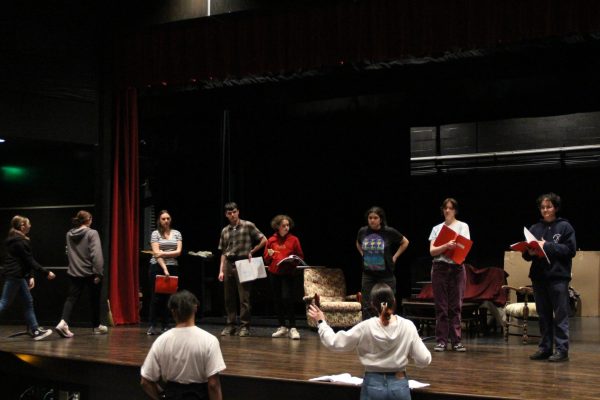Students Express Concern Over Bathroom Signage
Photo courtesy of Owen Tucker-Smith
One of the new bathroom signs on the first floor.
With time comes change, and one controversial change within Mt. Greylock has been the decision to change the signage on the bathrooms from “Girls” and “Boys” to “Urinals and Toilets” and “Toilets.” Members of the administration have repeatedly signaled both in official school documents and class meetings the expectation that boys and girls will still go to their gender’s assigned bathroom, which has provoked concern from members of the community.
In Mount Greylock’s “Nuts and Bolts,” the following information was published:
“The number of multi-stall and single restrooms has increased significantly with the new building, and students will have ready access to facilities. The multi-stall restrooms are designed like those in airports with strategically structured main entrances that provide privacy without a door. Individual toilet stalls have locking doors and urinals have privacy partitions. Signage for bathrooms in the new building is purpose-driven. Multi-stall bathrooms are labeled ‘Urinals & Toilets’ and ‘Toilets.’ Mount Greylock has every expectation that boys will continue to use the restrooms marked ‘Urinals & Toilets’ and girls will use the restrooms marked ‘Toilets.’”
Though there are single-stall bathrooms available, the administration has made clear that they are intended for teachers and are only to be used by students under special circumstances. This has upset a great number of students, many of whom claim that the administration is not making any actual changes to accommodate students whose identities fall outside of the binary genders. Upset students say that the administration is only switching what is written outside of the bathrooms and is effectively ostracizing and/or outing any kids who feel the need to use a genderless single restroom, all while claiming to be “ahead of the trend.”
The idea for new signs was sparked by Mount Greylock’s Gender-Sexuality Alliance, whose own Sophie Jones pioneered the change. Jones told the Echo that “[The GSA’s] original idea for the change was to make sure all students at the school felt comfortable using a bathroom without being labeled as ‘male’ or ‘female.’” However, some students seem to believe that the change in signage has not achieved this goal.
One of the first public protests against the bathroom signs was in senior Katrina Hotaling’s dissent, a combination of her and fellow senior Grace Miller’s opinions that was posted on Instagram. The post summed up a few important points raised by students who disagree with the new bathroom policy:
“Greylock’s attempt at new ‘inclusive’ and ‘progressive’ bathrooms is disingenuous… Changing the words on the doors to say different things when the intent is clearly still to segregate bathrooms into a men’s bathroom and a women’s bathroom doesn’t do anything. The bathrooms can be called anything under the sun, but as long as that intention to separate by gender is there, they may as well just say ‘men’ and ‘women,” said Hotaling.
Hotaling explained that “while single-stall all-gender restrooms were added, students were told they were mainly for teacher use but students could use them if circumstances made it necessary. Think from the perspective of a closeted trans student or a student that is simply uncomfortable using gang bathrooms. This student should not have to be singled out from other students in order to make themselves feel comfortable.”
This sentiment is felt by younger students as well. Sophomore Priya D’Souza said that the “administration claims it is a step towards progress when it’s literally three steps back… the way administration worded it was clear, too: If you are a girl, you HAVE to use the toilets bathroom; if you are a boy, you HAVE to use the urinals/toilets bathroom.”
D’Souza emphasized that the gender neutral teacher’s bathrooms wouldn’t be an easy solution for students who didn’t feel comfortable.
“It’s no longer the student’s prerogative to choose how they identify anymore,” said D’Souza. “If transgender/genderqueer students weren’t comfortable using the bathroom of their assigned sex, they have no choice but to use a gang bathroom, or ask the school for ‘special permission’ to use a gender neutral teacher’s bathroom – therefore immediately outing themselves to their peers. How is that fair?”
With so much controversy surrounding the choice around new signage, it is difficult to imagine an easy solution, especially considering the fact that the administration has already told all of the students the intent of the labeling. However, a few solutions have been offered by students.
Hotaling said that “to make it come across better, the single biggest thing admin can do would be to announce publicly that the all-gender restrooms are for anyone who wants to use them and normalize students using those so that trans students could use them without feeling uncomfortable/singled out.”
She further noted that “beyond that, I personally would advocate for changing the way the bathrooms are talked about, so rather than saying things like ‘toilets for girls, urinals for boys,’ because that’s not progressive, talk about the bathrooms in a gender-neutral way, just like the signs are.” Similar to this, D’Souza said that the best solution is to “just make gender neutral bathrooms – it’s obvious there’s enough space for them, considering how many teacher bathrooms there are.”
According to principal Mary MacDonald, “people have given pushback, to say, ‘why can’t we just have open bathrooms?’ And it’s like, no – this is a school. We are looking to have an opportunity for privacy and division.” MacDonald explained that the purpose driven bathrooms were a way “to achieve that separation without actually attributing gender to it.” However, upset students have expressed that the way that bathroom separation was explained to them in September makes it seem like now bathrooms are segregated by biological sex as opposed to gender identity, which may be a step backwards.
Another way to diffuse the issue could be to explain the purpose of the new signs better. Jones explained that “with the purpose-driven bathrooms, trans and non-binary students could use whatever bathroom they felt comfortable using as they were not labeled as male or female.”
Moving forward, said Jones, “the G.S.A. and I would like to see it explained less as ‘girls are expected to use the toilets bathroom and boys are expected to use the toilets and urinals’ and more of the idea that you are expected to use the bathroom that you feel comfortable using. We understand that it is a high school and middle school and that this new system may be taken advantage of, but we believe that the students will use it respectfully and trans and non-binary students will feel more comfortable if the bathrooms are explained differently.”





